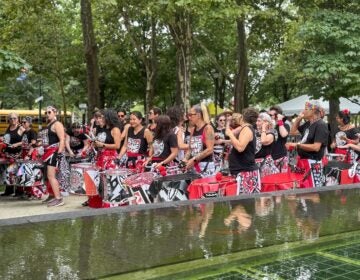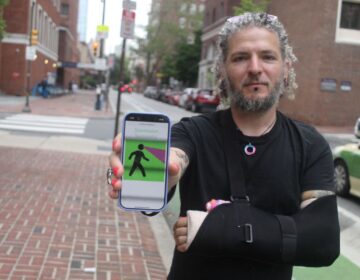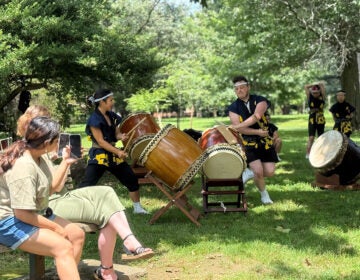Portraits of delegates from first United Nations meeting on display at Woodmere Art Museum
With the Woodmere Art Museum’s latest exhibit opening on Saturday, Deputy Director for Exhibitions, Sally Larson, was in an unusual position three days before opening night. The museum had yet to mount most of the placards for the 23 peerless portraits of 1946 United Nations delegates by Philadelphia artist Violet Oakley.
Larson entered the first-floor gallery, where the portraits are hanging, for a sneak preview with NewsWorks carrying a handful of white signage, which she propped on the floor beneath their respective pieces.
Larson explained that the verbiage for an exhibit like this can’t be rushed. “We have to check and double-check, because we have such a high regard for the United Nations and what Oakley wanted to support and record,” she said of ensuring historical accuracy.
In 1946, delegates from 51 nations arrived in New York City on the heels of World War II. The United Nations was convening for the very first time, and Oakley, a renowned portraitist and muralist whose work still decorates the chambers of the Pennsylvania State Capitol, was commissioned by the Philadelphia Evening Bulletin newspaper to capture the momentous meeting.
Local ties
Emma Hitchcock, Woodmere’s Collections Manager and a self-professed history buff, helped to set the scene. Without an official headquarters, the first United Nations talks were held in a high school gymnasium, and Oakley perched on the bleachers along with the press, wielding her charcoal and conté crayons.
Now, all but four of the portraits on display for “The Promise of Peace: Violet Oakley’s United Nations Portraits,” mounted in partnership with the Philadelphia International Festival of the Arts (PIFA), are part of Woodmere’s permanent collection.
“These pictures are among the greatest treasures we have at Woodmere,” said Director and CEO Dr. William Valerio.
Oakley’s history intertwines with Woodmere’s in many ways, including her longtime residence in West Mt. Airy and the large number of Oakley pieces – from these historic portraits to giant lunettes – that the museum holds.
Oakley’s partner, Edith Emerson, served as Woodmere’s director from 1940-1978.
Oakley, whose Quaker influences contributed to her lifelong advocacy for peace, was a natural choice to commemorate the first gathering of the UN.
“They connected on the highest personal level,” Larson said of why she has enjoyed researching and presenting the personages on display.
It was a gathering to “knit the world together in a new way” after the “horrors” of WWII, Valerio added.
Capturing “something deeper”
Of course there’s an ample record of this historic convocation in photographs, some of which, for context, are mounted in the exhibit.
Oakley’s portraits “capture something deeper about the emotions of this event,” Valerio explained. “She does something that a photographer can’t do,” capturing the urgency and gravity of the event’s emotional and psychological tone.
A standout piece in the exhibit is her portrait of USSR delegate Andrei Gromyko, the future Cold War statesman who would soon dominate American magazine covers.
Contrary to many portraits done in warm brown and rust tones, a boyish Gromyko appears in cool grays, the hooded eyes behind his glasses both expectant and wary.
Oakley’s own quotations about the men she sketched are reproduced alongside the drawings, helping to bring the scene to life.
“I studied long and carefully the representative from Russia, whenever he was present, which was not always however!” she noted of Gromyko. “I could see no variation of expression, and could but wonder what this unchanging countenance was guarding from me.”
She waxed lyrical about others, including the bald Brazilian delegate Dr. Pedro Leāo Veloso, whom she captured in a noble, contemplative profile.
“[H]is polished dome reflects the lights of the ceiling in the Council Room in a veritable constellation: he shines crowned with stars.”
Her portrait of the delegate from Poland also stands out: another man rendered in black and gray, looking at the viewer over his shoulder. His singularly haunted expression, Woodmere staffers speculate, alludes to the ravages of WWII in Poland.
All in all, the display includes portraits of delegates from the US, the United Kingdom, Mexico, Iran, China, Haiti, Australia and more. Some are captured in the middle of orations or conversations, their hands clutching papers or digging into their cheeks, and others are as graceful and inscrutable as classical busts.
The United Nations today
Valerio and his staff acknowledge that a gathering of the UN would look a little different today – all of the 1946 delegates Oakley represents here are men. But given the artist’s touch, Valerio isn’t worried about alienating female visitors still conscious of the comparative dearth of women in politics.
“Oakley’s fingerprints are in the room,” Valerio said. “I feel her presence glowing through.”
He and Larson hope that visitors to the exhibit will remember the ways the UN is still working to resolve problems of territory, power and influence, just as they were in the 1940s. Oakley’s pieces help us to understand the human figures behind the “broad trajectory of global history.”
In partnership with PIFA, Woodmere is offering a series of special events in conjunction with the exhibit, including lectures, Friday Night Jazz, movie screenings, and a talk from UN Ambassador Joseph M. Torsella on April 15.
“The Promise of Peace: Violet Oakley’s United Nations Portraits” runs from March 30 through June 30. The museum will hold an open house on Saturday, April 13 from 5 to 7 p.m.
WHYY is your source for fact-based, in-depth journalism and information. As a nonprofit organization, we rely on financial support from readers like you. Please give today.








